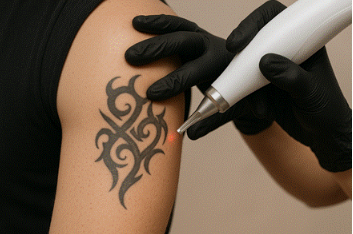Tattoo removal: Which inks are the hardest to remove with laser?

You want a clear, even result with as few surprises as possible. The honest answer is that not all inks behave the same under a laser. Pigment chemistry, particle size, layering and placement in the skin all shape how quickly ink clears or resists clearing. At NDN.LASER we design tatoeage verwijderen plans around these details, not averages, so your expectations match what is technically possible for your tattoo.
Lasers break pigment into smaller fragments through very short pulses of light. Two things decide how well that works: how strongly a pigment absorbs a specific wavelength, and how deep and dense the ink sits in your skin. Black carbon absorbs broadly and usually responds well. Certain bright or pastel colours absorb poorly at common wavelengths, or they sit in mixtures that behave unpredictably. Understanding this helps you judge timelines for tattoo removal without guesswork.
Why some colours fight the laser
Lasers break pigment into smaller fragments through very short pulses of light. Two things decide how well that works: how strongly a pigment absorbs a specific wavelength, and how deep and dense the ink sits in your skin. Black carbon absorbs broadly and usually responds well. Certain bright or pastel colours absorb poorly at common wavelengths, or they sit in mixtures that behave unpredictably. Understanding this helps you judge timelines for tattoo removal without guesswork.
Greens and light blues: The classic slow movers
Ask any experienced clinician which shades take the longest, and you will hear “green” and “light blue” again and again. Many green pigments (often phthalocyanine based) and sky blue tones have absorption peaks that make them less responsive to standard wavelengths. They can need more sessions, patient spacing and careful changes in settings to avoid overtreatment. We often plan longer intervals for lymphatic clearance and use test spots to map the best parameters. With steady work, tattoo removal still progresses just on a longer runway.
See also: How Smart Devices Are Helping Improve Mental Health
Yellow and orange: Visible late, stubborn early
Yellow and some oranges are less efficient light absorbers at the wavelengths commonly used in clinics. Early in the process, they may seem unchanged while surrounding colours fade. Over time, as ink density drops and the laser can “see” remaining particles more clearly, results improve. Expect more sessions and a focus on strict sun protection, because these tones can show post-inflammatory pigment shifts if treated on tanned skin. Conservative settings and patience keep tattoo removal safe here.
White and pastel mixes (titanium dioxide): The hidden hurdle
Pastel tints and “highlight” whites often contain titanium dioxide (TiO₂). This pigment scatters light rather than absorbing it, which limits direct fragmentation. It also sits in many mixed shades like mint, lilac or skin-tone blends used for cover ups. As darker components fade, the residual TiO₂ can make an area look chalky or unchanged. Managing expectations is key: tattoo removal can lighten the overall look, but ultra-bright pastels or heavy white highlights rarely vanish at the same pace as black lines.
Cover ups and layered inks: Complexity on complexity
A cover up can look like one image, but your skin still holds two (or more) separate layers of ink with different pigments and depths. The top design may clear in places and reveal the original work beneath, which can surprise clients midway. Planning for this outcome keeps the process calm. We often stage tattoo removal to reduce the top layer first, then reassess. Photographing progress in identical light helps you see real change even when colours appear to “swap places” during the series.

Cosmetic inks (brows, lips) and iron oxides: Proceed carefully
Many permanent makeup inks use iron oxides. Under laser energy, some of these pigments can darken temporarily due to chemical change. That does not mean the result is “ruined,” but it requires a measured approach and sometimes alternative strategies. A thorough patch test and a clear discussion of contingencies are essential before tattoo removal on cosmetic areas. For certain shades, gentler methods or staged plans may be safer.
UV reactive and “glow” inks: Uncertain composition
So called UV or glow inks are not a single chemistry; they are a marketing category. Because composition varies, so do laser responses. The safest route is always a conservative test spot and longer observation before committing to full field treatment. If your tattoo includes these accents, plan extra time and accept that tattoo removal might aim for softening rather than complete erasure in those zones.
Dense professional black vs. amateur black
Not all black is equal. Dense professional black lines and fills usually respond well but may need more sessions because there is simply more pigment to clear. Amateur tattoos often sit more superficially and can fade faster but if India ink or atypical carriers were used, reactions may vary. Good note-taking and parameter control session to session keep tattoo removal predictable across both cases.
Carrier fluids, depth and skin behaviour
Pigment does not travel alone; it is suspended in a carrier that influences how it spreads and sets in your dermis. Add in the artist’s technique, your body location (ankles and hands often clear slower), and your skin’s healing style, and you get a unique response curve. This is why we do test spots on tricky colours, extend intervals after strong reactions, and adjust energy in small steps. It is also why tattoo removal plans that look “slow” on paper often produce the most even long-term results in real life.
What technology can (and cannot) change
Modern platforms offer multiple wavelengths and very short pulse widths to address challenging pigments. That range matters. Yet technology cannot overwrite physics: if a pigment barely absorbs light in the available spectrum, progress will be gradual. The winning formula is smart device choice, careful parameter progression and disciplined aftercare. With that trio, tattoo removal becomes steady work rather than a gamble.
Practical ways to stack the odds in your favour
- Protect from sun throughout the series. Tanned skin raises the risk of pigment shifts, especially on yellows and pastels.
- Keep intervals realistic. Greens and light blues benefit from longer spacing so your immune system can clear fragments.
- Expect colour “reveals.” In cover ups, earlier layers can re-appear; this is normal, not a setback.
- Value the test spot. A small square can save sessions by pointing to the right settings for stubborn shades.
- Document consistently. Same camera, distance and lighting help you see progress that day to day eyes miss.
- Prioritise skin calm. Fragrance-free moisturiser once intact, avoid friction and heat for 24-48 hours, and follow aftercare precisely so tattoo removal stays on track.
How NDN.LASER sets expectations for tough colours
During consultation we map your colours, discuss pigment families in plain words, and flag any areas that are likely to take longer greens, sky blues, yellows, whites and pastels. We explain what the test spot can tell us and when it is worth doing. Then we set intervals that respect recovery and we record parameters after every visit. If your skin shows it needs a slower pace, we adjust. If a colour plateaus, we discuss options: more sessions, a blend of techniques, or a plan that aims for fade rather than complete clearance. That transparency keeps tattoo removal decisions grounded in your goals and your biology.
The takeaway
Some inks are simply harder. Greens and light blues absorb poorly at common wavelengths. Yellows, whites and pastels can hang on longer, especially when titanium dioxide is involved. Cover ups and cosmetic inks add layers of complexity. None of this means you cannot reach a satisfying end point. It means the plan has to match the pigments in your skin, not the average case on a chart. With measured settings, realistic spacing and careful aftercare, tattoo removal can turn even stubborn colours into a softer, quieter version of themselves or clear them completely over time. If you want a practical read on your own tattoo, book a consultation at NDN.LASER. We will identify the pigments, run test spots where it matters, and outline a schedule that protects your skin while moving steadily toward the result you have in mind. That is tattoo removal done with respect for both chemistry and your skin.
Let yourself be guided by the expertise of NDN.LASER for a lasting solution.



